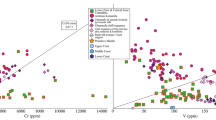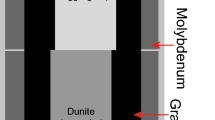Abstract.
The trace-element signature that cordierite (Crd) imparts to silicic magmas was evaluated by experiment using metapelite mineral mixtures to produce cordierite-bearing peraluminous granitic melts at 200 MPa (PH2O), from 700 to 850 °C. Most elemental partition coefficients vary with T. Beryllium is strongly compatible, with DBe Crd/melt values decreasing linearly from 202.0 to 6.7 as T rises from 700 to 850 °C. Manganese is compatible (DMn Crd/melt=7.67 to 1.92 over the same range of T), and shows similar values to those reported for biotite in silicic melts. Incompatible components include Li, Rb, B, F and P, although Cs is nearly compatible in cordierite, especially at higher T (DCs Crd/melt=~0.19 to 0.60) where the large alkalis are better accommodated structurally. Cordierite appears to be the most effective crystalline reservoir of Be and Cs in metapelites and their anatectic melts. Natural data support the hypothesis that Crd, when present in granitic melts, sequesters Be, Cs and, in the absence of garnet, Mn. S-type granitic rocks containing Crd show consistently low Be contents (mean=0.8 ppm Be with an average range of <1 to 1.20) whereas Crd-free granites (e.g., containing accessory garnet) exhibit distinctly higher Be contents (mean=6 ppm Be with an average range of 3 to 12). These values increase further in evolved facies (mean=69 ppm Be with a an average range of 11 to 145) which commonly give rise to beryl-bearing pegmatites. Whole-rock signatures of Be discriminate source environments of silicic magmas at a resolution equal to the boundaries of the cordierite stability field – e.g., at the P–T–X conditions where cordierite gives rise to garnet+aluminum silicate. Cordierite-bearing granitic rocks contain low Cs contents (mean=1.8 ppm Cs) compared to the Crd-free equivalents (mean=18 ppm Cs). Mn contents also correlate with the presence (mean=0.01 wt% MnO) or absence of Crd (mean=0.09 wt% MnO). Depending on its contribution to anatexis, cordierite may either give or take S-type chemical character from granitic liquids, resulting in a distinctive Crd-associated group of S-type elements. This signature is different from that of micas (high Li, F and, to a lesser degree, Be and Mn). Whole-rock compositions of granites, coupled with notable absences of beryl in their associated pegmatites, indicate that a sizable population of S-type granites originated from Crd-bearing sources. The normative Crd component of silicic peraluminous melts is ≤4 wt% to 850 °C. Higher modal contents of cordierite reflect either restite entrainment or peritectic reactions which produce Crd after magma ascent to shallow depths. The distinctive trace-element signature of cordierite now provides improved resolution of the source mineralogy for S-type magmas.
Similar content being viewed by others
Author information
Authors and Affiliations
Additional information
Electronic Publication
Rights and permissions
About this article
Cite this article
Evensen, J.M., London, D. Experimental partitioning of Be, Cs, and other trace elements between cordierite and felsic melt, and the chemical signature of S-type granite. Contrib Mineral Petrol 144, 739–757 (2003). https://doi.org/10.1007/s00410-002-0426-x
Received:
Accepted:
Issue Date:
DOI: https://doi.org/10.1007/s00410-002-0426-x




